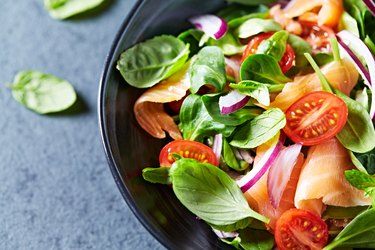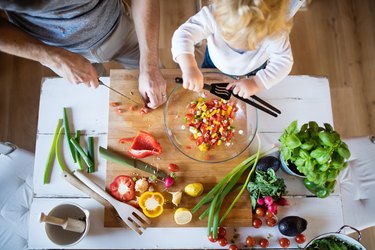
Losing weight by eating more is like winning the weight-loss lottery — it sounds almost too good to be true. But that's the idea behind volume eating: You eat more because you're choosing foods that are high in nutrients and low in calories.
Swapping some of the high-calorie choices in your diet for high-volume, low-calorie foods can help you maintain a calorie deficit while warding off hunger (because no one likes a grumbling stomach). Here's what to know to get started.
Video of the Day
Video of the Day
What Is Volume Eating?
To understand how eating more can actually help you lose weight, you need to ditch the "more food equals more calories" mentality and start thinking about the quality of the food you're eating. Once you've got that down, volume eating is pretty simple: Replace high-calorie foods with lower-calorie, nutrient-dense foods and eat more of the latter, Shena Jaramillo, RD, registered dietitian and founder of Peace & Nutrition, tells LIVESTRONG.com.
Volume eating isn't really a diet plan or regimen but rather a technique. Simply put, this hack involves strategically packing your meals with large amounts of low-calorie foods. As a result, you feel full while cutting calories.
Most of the high-calorie choices in a typical diet are processed foods, like granola bars, chips or soda. These may taste delicious but they pack a high-calorie punch for very little total food. Plus, they're typically way lower in total nutrients.
Take a look at the chart below to get an idea of how different foods compare calorie-wise per serving.
High-Volume Foods vs. Low-Volume Foods
Low-Volume Food | High-Volume Food | Serving Size | Calories |
|---|---|---|---|
1 cup | 205 | ||
1 cup | 7 | ||
1 serving | 465 | ||
1 cup | 55 | ||
12 oz | 192 | ||
Water | 12 oz | 0 |
High-Volume, Low-Calorie Foods

1. Vegetables
The easiest way to eat more food for fewer calories is by filling your meals with plenty of vegetables. Leafy greens have a higher water and fiber ratio to total calories, so you can eat several cups each day while barely adding any calories to your diet.
For instance, a cup of arugula has fewer than 20 total calories, according to the USDA, but can add substantial volume to your plate, helping you feel full. Other high-volume, low-calorie leafy greens to include are:
- Kale: 7 calories per cup
- Spinach: 7 calories per cup
- Romaine lettuce: 7 calories per cup
- Cabbage: 22 calories per cup
2. Whole Grains
Swapping refined grains (like white bread and white rice) for whole grains can also increase the volume of your meal, Jaramillo says. Whole grains are not only higher in fiber, but they also offer more nutrients, like fiber, iron and magnesium.
Some whole grain options include:
- Whole-grain oats: 150 calories per half cup
- Brown rice: 150 calories per half cup
- Millet: 207 calories per cup
- Barley: 170 calories per quarter cup
3. Lean Protein
Leaner protein options are also typically lower in calories than higher-fat proteins and can be eaten in higher quantities. Swap red meat and full-fat dairy for some of these higher-volume options:
- Chicken breast: 165 calories per serving (about 3.5 ounces)
- Salmon: 232 calories per serving (about 3.5 ounces)
- Nonfat yogurt: 129 calories per cup
- Cottage cheese: 110 calories per cup
- Ground turkey: 160 calories per half cup
Related Reading
3 Benefits of Volume Eating
1. It Helps Promote Weight Loss
Swapping low-volume options for high-volume, low-calorie foods usually means you'll be eating a more filling diet for fewer calories, which ultimately promotes fat loss. In order to lose weight, you need to create a calorie deficit (when you burn more calories than you consume), according to the Mayo Clinic.
2. You Feel Fuller
Calorie-restricted diets can be difficult because they can leave you feeling hungry. Eating more volume can keep you more satiated and make it easier to stick with your diet.
One key nutrient you gain with more voluminous foods is fiber, Jaramillo says. Fiber not only increases satiety after a meal (aka helps you feel full), but it can also promote weight loss and dietary adherence, according to an October 2019 study in The Journal of Nutrition. After observing the effects of different diets in 345 people, researchers found that fiber was the most surefire predictor of weight loss.
3. You Get More Nutrients
Volume eating can also increase the overall nutritional value of your meals, Jaramillo says. Foods that are high-volume, like leafy greens and lean proteins, are generally more vitamin- and mineral-packed than low-volume alternatives, like processed foods.
3 Possible Drawbacks of Volume Eating

As this eating routine emphasizes whole foods high in nutrients, just about anyone can benefit from focusing on volume and quality of food, Jaramillo says. Still, there are a few potential downsides to consider.
1. There Are No Strict 'Rules'
Volume eating isn't a step-by-step diet routine or regimen, so if you're someone who likes to follow rules, this way of eating may be difficult for you to stick with.
2. It Can Be Time-Intensive
Volume eating takes some planning and can be challenging for those with a hectic schedule or rigorous physical activity regimen, says Jaramillo.
If you're a granola-bar-on-the-go kind of person, you may want to try meal prepping at the beginning of the week, so your food is ready when you are.
3. More Fiber Could Cause Tummy Troubles
As you begin eating a more voluminous diet, you may experience some initial GI distress, Jaramillo warns. Especially if you're not typically eating much fiber, introduce these fiber-heavy foods more gradually.
While it will take some more commitment where prep is concerned, eating more voluminous foods, like vegetables, whole grains and lean proteins, can help you stay in a calorie deficit and provide your body with plenty of vitamins and nutrients. Let your creative side run wild and experiment with adding more volume to your meals.
Related Reading
- USDA: "Arugula, Raw"
- USDA: "Kale, Raw"
- USDA: "Spinach"
- USDA: "Romaine Lettuce, Raw"
- USDA: "Cabbage, Raw"
- USDA: "Whole Grain Oats"
- USDA: "Brown Rice"
- USDA: "Millet, Cooked"
- USDA: "Barley"
- USDA: "Chicken Breast"
- USDA: "Salmon"
- USDA: "Nonfat Yogurt"
- USDA: "Cottage Cheese"
- USDA: "Ground Turkey"
- The Journal of Nutrition: "Fiber Intake Predicts Weight Loss and Dietary Adherence in Adults Consuming Calorie-Restricted Diets: The POUNDS Lost (Preventing Overweight Using Novel Dietary Strategies) Study."
- Mayo Clinic: "Counting Calories: Get Back to Weight-Loss Basics"
Was this article helpful?
150 Characters Max
0/150
Thank you for sharing!
Thank you for your feedback!